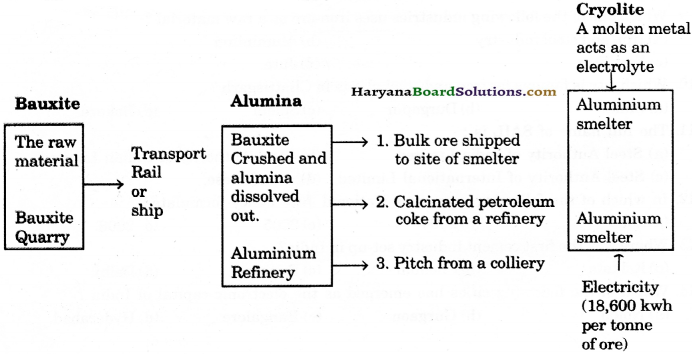Haryana State Board HBSE 10th Class Social Science Solutions Geography Chapter 6 Manufacturing Industries Textbook Exercise Questions and Answers.
Haryana Board 10th Class Social Science Solutions Geography Chapter 6 Manufacturing Industries
HBSE 10th Class Geography Manufacturing Industries Intext Questions and Answers
Textbook (Page No. 63)
On the occasion of Diwali, Harish went to a market with his parents. They purchased shoes and clothes for him. His mother purchased utensils, sugar, tea and diyas (earthen lamps). Harish observed that the shops in the market were flooded with items for sale. He wondered how so many items could be made in such large quantities. His father explained that shoes, clothes, sugar etc. are manufactured bjr machines in large industries, some utensils are manufactured in small industries, while items like diyas are made by individual artisans in household industry.
Manufacturing Industries Class 10 Solutions HBSE Geography Question 1.
Do you have some ideas about these industries?
Answer:
Yes, on the basis of production, industries are classified into three types :
(i) Large Scale Industry : Clothes, sugar etc.
(ii) Small Scale Industry : Shoes, utensils etc.
(iii) Cottage Industry : Diyas (Earthen Lamps).
Textbook (Page No. 65)
Manufacturing Industries Chapter 6 HBSE 10th Class Geography Question 2.
Classify the following into two groups on the basis of bulk and weight of raw material and finished goods :
(i) Oil
(ii) Knitting needles
(iii) Brassware
(iv) Fuse wires
(v) Watches
(vi) Sewing Machines
(vii) Ship building
(viii) Electric bulbs
(ix) Paint brushes
(x) Automobiles.
Answer:
On the basis of bulk and weight of raw material and finished goods, industries are classified into two categories : (i) Heavy Industries and (2) Light Industries.
![]()
Heavy Industry:
(i) Shipbuilding
(ii) Automobiles.
Light Industry:
(i) Oil
(ii) Knitting needles
(iii) Brassware
(iv) Fuse wires,
(v) Watches
(vi) Sewing Machines
(vii) Electric bulbs
(viii) Paint brushes.
Textbook (Page No. 66)
Chapter 6 Manufacturing Industries HBSE 10th Class Geography Question 3.
Why did Mahatma Gandhi lay emphasis on spinning yarn and weaving khadi?
Answer:
- So that large number of people could be employed
- For promoting the cottage industries
- To develop the feeling of nationalism
- To reduce dependence on foreign clothes,
- to boycott foreign clothes.
Question 4.
Why is it important for our country to keep the mill sector loomage lower than power loom and handloom?
Answer:
It is important for our country to keep the mill sector loomage lower than power- loom and handloom because, through power loom and handloom, large number of people get employment.
Textbook (Page No. 68)
Question 5.
Why is it important for us to improve our weaving sector instead of exporting yarn in large quantities?
Answer:
It is important for us to improve our weaving sector instead of exporting yarn in large quantities because :
- By improving the weaving sector, people can get jobs on large scale.
- It will increase textile production.
- Fine quality of cotton products and clothes can be prepared.
- Extra quantities of textile can be exported, through which, maximum foreign currency can be earned.
![]()
Textbook (Page No. 69)
Question 6.
Make a list of all such goods made of steel that you can think of.
Answer:
- Tables
- Chairs
- Doors
- Utensils
- Boxes
- Electrical appliances
- Medical appliances
- Motorcars
- Cycles
- Railway bridges
- Windows
- Rods etc.
Textbook (Page No. 69)
Table 6.1 : Total finished steel production in India.
| Year | Production (in metric tonnes per annum) |
| 2013-14 | 7.67 |
| 2014-15 | 92.16 |
| 2015-16 | 91.00 |
| 2016-17 | 101.3 |
| 2017-18 | 86.69 |
Question 7.
Why is the per capita consumption of steel so low in India?
Answer:
The per capita consumption of steel is so low in India because :
- Per capita income is very low in India.
- Living standard is very low.
- Durable substitutes of steel are available at very low prices and they are also very light weight.
Question 8.
Collect information about products of steel plants in India.
Answer:
Major products of steel plants in India are wire, steel sheets, wheels, rail lines, rings and bearings, wire rods etc.
![]()
Textbook (Page No. 71)
Question 9.
Collect information from different sources and discuss.
Answer:
The Tata group has contracted with the government of Odisha to set up a giant steel plant in the Kalingnagal area. As the tribals livings in this area would have lost their land and their livelihoods would be threatened, they revolted on 2nd January 2006, and in a police firing incident, 13 tribals were killed.
Textbook (Page No. 72)
Question 10.
A factory produces aluminium saucepans with plastic handles. It obtains aluminium from a smelter and a plastic component from another factory. All the manufactured saucepans are sent to a warehouse :
(a) Which raw material is likely to be most expensive to transport and why?
Answer:
Aluminium is likely to be most expensive to transport, because it is heavier than plastic.
(b) Which raw material is likely to be the cheapest to transport and why?
Answer:
Plastic is likely to be the cheapest to transport, because it is light in weight.
Question 11.
Do you think the cost of transporting the finished products after packaging is likely to be cheaper or more expensive than the cost of transporting aluminium and plastic? Why?
Answer:
Transporting the finished products after packaging is likely to be more expensive than the cost of transporting aluminium and plastic, because:
- They will occupy more space.
- The destination of finished products is not an industry, but the whole of country, and sometimes, the whole world.
- Finished products need delicate care. Therefore, transporting them needs extra cost in their packaging.
- The finished products have to be sent to different destinations.
Textbook (Page No. 73)
Question 12.
Where would it be economically viable to set up the cement manufacturing units?
Answer:
The ideal locations to set up the cement manufacturing units are :
- The units should be set up close to the availability of raw material because this industry requires bulky and heavy raw material.
- The place should have continuous supply of electric power.
- The place should have efficient network of railways and road transport.
Question 13.
Find out where the cement plants are located in other states of India. Find their names.
Answer:
- Madhya Pradesh: Katni, Satna, Damoh, Gwalior, Neemuch, etc.
- Andhra Pradesh: Panayam, Manchharela, Machhalipatnam, Vijaywada, Karimnagar, Krishna, etc.
- Tamil Nadu: Tirunalvaley, Rajmalyalam, Durg, Dalmiya Nagar, etc.
- Karnataka: Shahabad, Bhadravati, Bijapur, Tumkur, Bagalkot, etc.
- Jharkhand: Sindri, Japla, Kalyanpur, Dalmiyanagar, etc.
![]()
HBSE 10th Class Geography Manufacturing Industries Textbook Questions and Answers
1. Multiple Choice Questions
(i) Which one of the following industries uses limestone as a raw material?
(a) Aluminium
(b) Cement
(c) Plastic
(d) Automobile
Answer:
(b) Cement.
(ii) Which one of the following agencies markets steel for the public sector plants?
(a) HAIL
(b) SAIL
(c) TATA Steel
(d) MNCC.
Answer:
(b) SAIL
(iii) Which one of the following industries uses bauxite as a raw material?
(a) Aluminium smelting
(b) Cement
(c) Paper
(d) Steel.
Answer:
(a) Aluminium smelting.
![]()
(iv) Which one of the following industries manufactures telephones, computer etc?
(a) Steel
(c) Aluminium smelting
(b) Electronic
(d) Information Technology.
Answer:
(d) Information Technology.
2. Answer the following briefly in not more than 30 words:
(i) What is manufacturing?
answer:
Production of goods in large quantities after processing them from raw material to more valuable articles is called manufacturing.
(ii) Name any three physical factors for the location of industries. 2019
Answer:
- Availability of raw material
- Climate
- Sources of Power.
(iii) Name any three human factors for the location of industries. 2019
Answer:
- Availability of human labour
- Availability of capital
- Market.
(iv) What are basic industries? Give an example.
Answer:
Those industries, which supply their products or raw material to manufacture other goods, are called basic or key industries. Examples – Iron and Steel industry.
(v) Name the important raw materials used in the manufacturing of cement.
Answer:
This industry requires bulky and heavy raw materials, like limestone, silica and gypsum.
![]()
3. Write the answers of the following questions in 120 words:
(i) How are integrated steel plants different from mini steel plants? What problems does the industry face? What recent developments have led to a rise in the production capacity?
Answer:
(1) An integrated steel plant is large and handles everything in one complex. On the other hand a mini steel plant is smaller, has electric furnace, uses steel scrap and sponge iron. It produces mild and alloy steel of a given specification. It is a decentralised secondary unit, which specialises in one or two processes only.
(2) Problems of Steel Industry: In the present time, India is an important iron and steel producing country in the world. We are unable to perform to our full potential, largely, because of the following problems faced by iron and steel industry.
(a) High costs and limited availability of coking coal.
(b) Lower productivity of labour.
(c) Irregular supply of power.
(d) Poor infrastructure.
(3) Recent Developments: Recent developments that have led to a rise in the production capacity are as follows :
(a) Liberalisation
(b) Foreign Direct Investment (FDI)
(c) Efforts of Private Entrepreneurs.
(ii) How do industries pollute the environment?
Answer:
Industries are responsible for four types of pollution :
(a) Air
(b) Water
(c) Land
(d) Noise.
(a) Air Pollution: It is caused by the presence of high proportion of undesirable gases, such as sulphur dioxide and carbon monoxide. Smoke is emitted by chemical and paper factories, brick kilns, refineries and smelting plants, and burning of fossil fuels in big and small factories, that ignore pollution norms. Toxic gas leaks can be very hazardous with long-term effects. Air pollution adversely affects human health, animals, plants, buildings, and the atmosphere, as a whole.
(b) Water Pollution: The main culprits in this regard are paper, pulp, chemical, textile and dyeing, petroleum refineries, tanneries and electroplating industries, that let out dyes, detergents, acids, salts and heavy metals, like lead and mercury pesticides, fertilisers, synthetic chemicals with carbon, plastics and rubber, etc. into the water bodies.
![]()
(c) Thermal Pollution: Thermal pollution of water occurs when hot water from factories and thermal plants is drained into rivers and ponds, before cooling. Wastes from nuclear power plants, nuclear and weapon production facilities, cause cancers, birth defects and miscarriages.
(d) Noise Pollution: Noise Pollution is very harmful for human, as well as animal life. Unwanted sound is an irritant and a source of stress. It not only results in irritation and anger but can also cause hearing impairment, increased heart rate and blood pressure among other physiological effects.
(iii) Discuss the steps to be taken to minimise environmental degradation by industry.
Answer:
To minimise the environmental degradation by industry, the following steps can be taken:
(i) Minimising use of water for processing by reusing and recycling it in two or more successive stages.
(ii) Harvesting of rainwater to meet water requirements.
(iii) Treating hot water and effluents before releasing them in rivers and ponds. Treatment of industrial effluents can be done in three phases –
(1) Primary treatment, by mechanical means. This involves screening, grinding, flocculation
and sedimentation. –
(2) Secondary treatment, by biological process.
(3) Tertiary treatment, by biological, chemical and physical processes. This involves recycling of waste water.
(iv) Smoke can be reduced by using oil or gas instead of coal in factories.
(v) Over exploitation of water should be prohibited by legal framework.
(vi) Use of silencers fitted with machinery and equipments that cause noise pollution. Earphones and earplugs to be given to employees.
(vii) Ensuring use of smoke stacks with electrostatic precipitators, fabric filters, scrubbers and internal separators.
![]()
Knowledge Basket
Activity
Give one word for each of the following with regard to industry. The number of letters in each word are hinted in brackets :
(i) Used to drive machinery – (5) P.
(ii) People who work in a factory – (6) W
(iii) Where the product is sold – (6) M.
(iv) A person who sells goods – (8) R.
(v) Thing produced – (7) P.
(vi) To make or produce – (11) M.
(vii) Land, Water and Air degraded – (9) P
Answer:
(i) Power
(ii) Worker
(iii) Market
(iv) Retailer
(v) Product
(vi) Manufacture
(vii) Pollution.
Select one agro-based and one mineral-based industry in your area.
(i) What are the raw materials they use?
(ii) What are the other inputs in the process of manufacturing that involve transportation costs?
(iii) Are these factories following environmental norms?
Answer:
Agro-based Industry – Sugar Industry :
(i) Sugar cane,
(ii) Capital, labour, power, water and transportation etc.
(iii) Yes, these factories are following environmental norms.
![]()
Mineral-based Industry – Cement Industry :
(i) Limestone, dolomite, silica, gypsum and coal.
(ii) Capital, labour, electricity, water and transportation etc.
(iii) No, these factories are not following environmental norms.
Activity
Solve the puzzle by following your search horizontally and vertically to find the hidden answers :
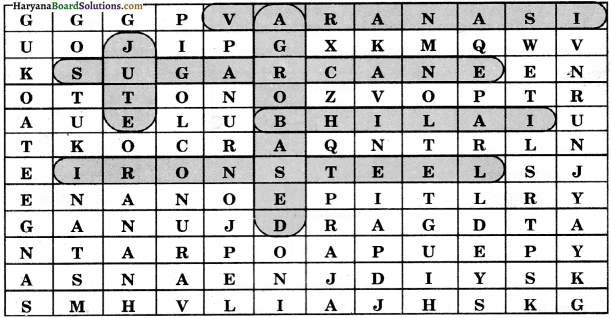
1. Textiles, sugar, vegetable oil and plantation industries deriving raw materials from agriculture are called
2. The basic raw material for sugar industry.
3. This fibre is also known as the ‘Golden Fibre’.
4. Iron-ore, coking coal, and limestone are the chief raw materials of this industry.
5. A public sector steel plant located in Chhattisgarh.
6. Railway diesel engines are manufactured in Uttar Pradesh at this place.
Answer:
l. Agro-based
2. Sugar cane
3. Jute
4. Iron-steel
5. Bhilai.
6. Varanasi.
Draw a line diagram of industry-market linkage. (Page No. 64)
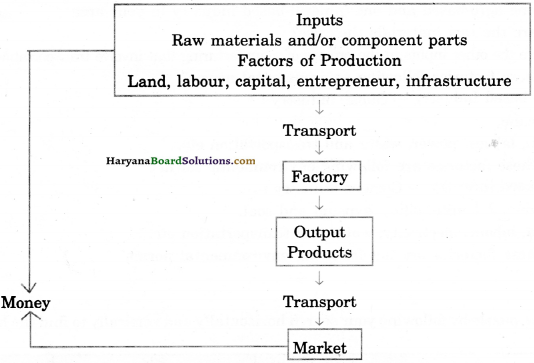
Answer:
Industry Market linkage –
Draw a line diagram of an ideal location of an industry. Page No. 64)
Answer:
Ideal location of an industry
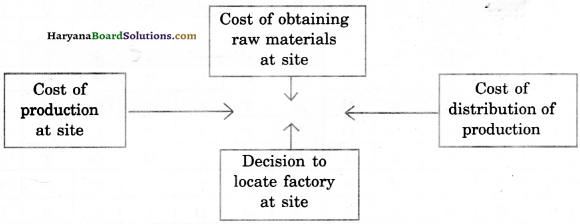
How the value is added in the Textile industry? (Page No. 66)
Answer:
Value addition in the Textile industry
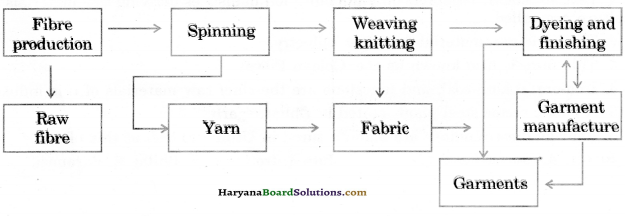
Trace the process of manufacture of steel through a line diagram. (Page No. 69)
Answer:
Processes of manufacture of steel

Show the process of manufacturing of Aluminium through a line diagram.
Answer:
Process of manufacturing of Aluminium:
